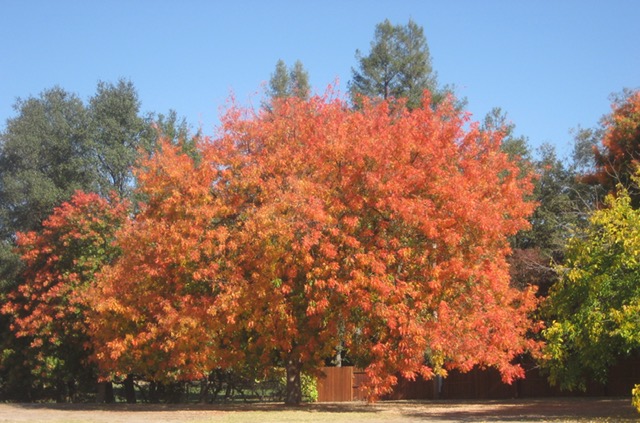
Want to help? Sacramento Tree Foundation has many activities

|
|
Trees in many colors -- one of the great things about the outdoors in fall. Help
plant trees or learn more about them through the Sacramento Tree
Foundation. (Photo: Kathy Morrison)
|
Trees are the stars of fall. Their changing colors demand notice, giving the landscape new looks every day as the green leaves turn to red or gold or orange, and then drop to the ground. A fluffy tree one day -- looking at you, gingko -- can be a sketch of itself the next.
Fall is the best time to plant trees, too. The soil still is warm, which allows roots to grow, but the air temperatures are moderate, so the young tree isn't under heat stress.
The Sacramento Tree Foundation is in the midst of its fall neighborhood tree planting and care events, and welcomes volunteers of any age, with or without tree-planting experience.
-- Sierra Woods, Folsom, 8:45 a.m. to noon, Saturday, Nov. 6. Trees will be planted at several residents' homes.
-- Fisherman's Lake, Natomas, 1-4 p.m. Sunday, Nov. 7. This is a mulch-spreading event for the native trees that were planted at the site a few years ago.
-- Jordan Family Park, Elk Grove, 9 a.m. to noon, Saturday, Nov. 13. This is a reforestation activity for the park, with native trees to be planted along a bike path. Mulching also will be done.
-- Old North Sacramento, 8:45 a.m. to 1 p.m., Saturday, Dec. 11. This event will add street trees to the neighborhood.
If you'd prefer to look and learn about some of Sacramento's trees, and have a bike available, this Sunday the SacTree folks are leading a tour of the Hollywood Park neighborhood's trees starting at 1 p.m. It will conclude at 5 p.m. at Two Rivers Cider.
And SacTree on Nov. 20 plans an acorn harvesting day from 9 a.m. to noon. Location is still TBA.
Register for all SacTree activities at https://www.sactree.com/events .
Meanwhile, here are some things to remember when planting trees:
-- Don't plant a tree too deep. The "root flare" should be at or slightly above the soil line to keep the tree from suffocating. The planting hole should be no deeper than the actual rootball, but it should be wide.
-- Remove the nursery stake. It's there only to protect the tree during transit -- it's not meant to be left on while the tree grows, and actually can limit its growth.
-- If stakes are necessary to keep the tree upright, there should be a pair of them, each about 18 inches away from the trunk, attached with loops that let the tree sway. That's how it gets stronger! Then remove the stakes after a year or two, depending on its growth.
These and other tips for tree-planting can be found at sactree.com/howtoplant and, for fruit trees specifically, in this UC Agriculture and Natural Resources publication, https://anrcatalog.ucanr.edu/pdf/8048.pdf .
Comments
0 comments have been posted.Sacramento Digs Gardening to your inbox.
Sites We Like
Garden Checklist for week of May 12
Get your gardening chores and irrigation done early in the day before temperatures rise.
* Plant, plant, plant! It’s prime planting season in the Sacramento area. Time to set out those tomato transplants along with peppers and eggplants. Pinch off any flowers on new transplants to make them concentrate on establishing roots instead of setting premature fruit.
* Direct-seed melons, cucumbers, summer squash, corn, radishes, pumpkins and annual herbs such as basil.
* Harvest cabbage, lettuce, peas and green onions. This heat will cause leafy greens and onions to flower; pick them before they bolt.
* In the flower garden, direct-seed sunflowers, cosmos, salvia, zinnias, marigolds, celosia and asters.
* Plant dahlia tubers. Other perennials to set out include verbena, coreopsis, coneflower and astilbe.
* Transplant petunias, marigolds and perennial flowers such as astilbe, columbine, coneflowers, coreopsis, dahlias, rudbeckia and verbena.
* Keep an eye out for slugs, snails, earwigs and aphids that want to dine on tender new growth.
* Feed summer bloomers with a balanced fertilizer.
* For continued bloom, cut off spent flowers on roses as well as other flowering plants.
* Got fruit trees? If you haven't already done so, thin orchard fruit such as apples, peaches, pears, pluots and plums before they grow too heavy, breaking branches or even splitting the tree. Leave the largest fruit on the branch, culling the smaller ones, and allow for 5 to 6 inches (or a hand's worth) between each fruit.
* Thin grape bunches, again leaving about 6 inches between them. For the remaining bunches, prune off the "tail" end, about the bottom third of the bunch, so that the plant's energy is concentrated in the fruit closest to the branch.
* As spring-flowering shrubs finish blooming, give them a little pruning to shape them, removing old and dead wood. Lightly trim azaleas, fuchsias and marguerites for bushier plants.
* Add mulch to the garden to help keep that precious water from evaporating. Mulch also cuts down on weeds. But don’t let it mound around the stems or trunks of trees or shrubs. Leave about a 6-inch to 1-foot circle to avoid crown rot or other problems.